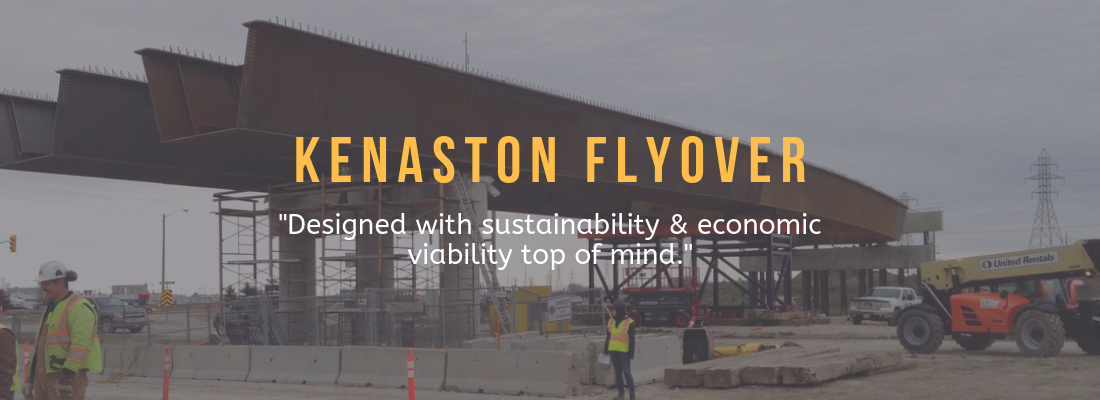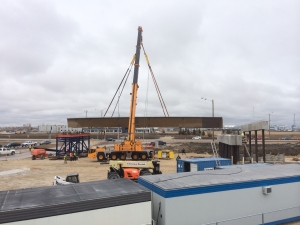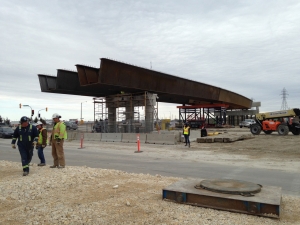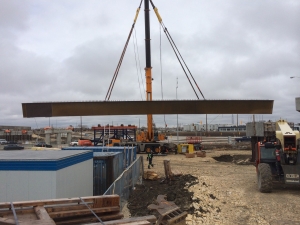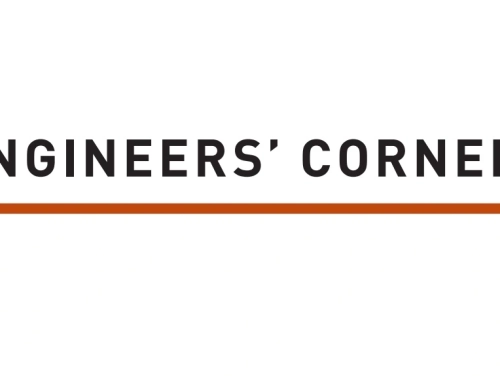In a city not often lauded for its traffic planning decisions, the Kenaston Flyover in Winnipeg is clearly an exception to the rule. Situated around a curve joining two well-established 80 km per hour thoroughfares in the city—the bridge has been widely recognized, and awarded, for its innovative design and construction features.
By James Peters
The project received the 2017 Canadian Institute of Steel Construction Manitoba/Northwestern Ontario steel design award for bridges. The flyover is situated around the merging curve of Bishop Grandin and Kenaston boulevards, and a part of Winnipeg’s Waverley West arterial roads system.
Trapezoidal Box Girders
Undoubtedly a key component in the project’s success, Capitol Steel (Winnipeg) fabricated and erected the six trapezoidal box girders in two lines of three—each measuring seven feet in depth, 11 feet in width and 115 feet in length. Kris Overwater, Capitol’s chief operating officer, describes the challenge, “A flyover isn’t unique but it hadn’t been used in Winnipeg before. It’s simply a traffic bridge that allows a thoroughfare to continue flowing uninhibited underneath the structure. What made this project a little more complex was the bridge being constructed on the curve where Bishop Grandin and Kenaston boulevards meet. But traffic essentially stayed open with only a few closures and lane drops.”
Steel was clearly the ideal choice for the flyover for all of its usual advantages, such as strength and durability. The horizontal curves and super-elevated deck on the bridge earmarked the project for steel construction at the outset. And although the structure didn’t present any insurmountable problems—it had some challenges.
Overwater says, “The geometries on this bridge were extremely complex and required high tolerances and quality metrics throughout. The curved design called for a trapezoidal tub girder system—as opposed to a standard three-plate girder solution—making for a unique construction task. With a standard three-plate girder system you typically have a top and bottom flange joined together with the middle web, so your profile looks like an I. And when you connect I-girders you have three access points—top, bottom and centre. But a tub girder is essentially two I’s on a cant with a longer bottom flange, looking like a tub in profile. While there’s more surface area to connect tub girders, you have to be much more accurate with your connecting points as a result.”
Complicating matters was the magnitude of the steel and the length of the girders, which were all over 100 feet in length. Overwater says, “With those lengths, the girders can move, depending on air temperature and direct sunlight. And complicating things is the way construction cranes normally handle girders to tilt and fit the pieces together. But those connections were made much easier for the flyover project by using a computerized hydraulic cylinder system—meaning we could alter the craning with very refined calculations and degree points to make the fit closer. It worked beautifully.”
The tub girders used for the Kenaston Flyover were a first for Capitol Steel. Overwater adds, “We’re currently using tub girders for the Neptune Bulk Terminals project in the Vancouver port. The bridge in the port is actually very similar to the Kenaston project scenario.”
Steel tub Girder Application Issues*
Steel tub girder use is becoming more commonplace in modern infrastructure design. The system offers several advantages over other superstructure types in terms of span range, stiffness and durability — particularly in curved bridges. In addition, the structures have an aesthetic advantage because of their clean, simple appearance. But the girders are not a panacea—there is an inherent complexity to their use—especially when it comes to construction loading stages. Designers need to carefully consider each bridge on a case-by-case basis to determine if steel tub girders are an appropriate superstructure choice.
Much of the criteria depends on:
- Span ranges: Steel tub girders are generally more economical in mid-span ranges, from about 150 to 500 feet.
- Curvature: The torsional strength and rigidity of tub girders make them excellent choices for curved structures with tight radii of curvature.
- Aesthetics: Their smooth uncluttered form and the reduced number of girders give steel tub girder bridges a clean, simple appearance.
- Durability and maintenance: Since many elements of tub girders are located inside the box section and protected from the elements they exhibit greater durability.
- Economy: Tub girders are not inexpensive but do offer economically competitive solutions in difficult design situations.
*From Practical Steel Tub Girder Design, 2005, Coletti, Fan, Holt, Vogel.
Dillon Consulting
Canada’s Dillon Consulting firm acted as the primary consultant on the project and was responsible for the flyover’s design and contract administration. Paraphrasing some of the details outlined in the firm’s presentation from the 2016 Transportation Association of Canada conference, “Designed with sustainability and economic viability top of mind, the Kenaston Flyover clearly demonstrates Winnipeg’s efforts to reduce infrastructure life-cycle costs and meet the increasing demands on infrastructure in a limited space. The project illustrated the benefits of using the technologies and techniques available to efficiently use resources—including land and available funds.”
And the true measure of the Kenaston Flyover’s success? A grudging acceptance from Winnipeg drivers; no minor accomplishment itself.
About Capitol Steel
Capitol Steel has offices in Montreal and Winnipeg and excels at the fabrication and erection of unique, complex and heavy structural steel projects. With very diverse experiences and intricate and methodical techniques, Capitol Steel has added much value to many of the projects it’s been associated with. Capitol Steel has grown into a highly specialized, structural steel fabricator and erector for some of the largest and most demanding projects in the public infrastructure, commercial construction and heavy industrial sectors.
About Dillon Consulting
One of Canada’s Best Managed Companies, Dillon Consulting has evolved into a major engineering consulting organization. From its humble beginnings in London, Ontario over 70 years ago, Dillon offices can be found in most of Canada’s major cities. The Winnipeg office was responsible for the Kenaston Flyover design.
Project Team
Client: City of Winnipeg
General Contractor: M.D. Steele Construction Ltd.
Design and Contract Administration: Dillon Consulting
Fabricator/Erector: Capitol Steel
*This article was originally published in Advantage Steel no. 62 and can be found here.

